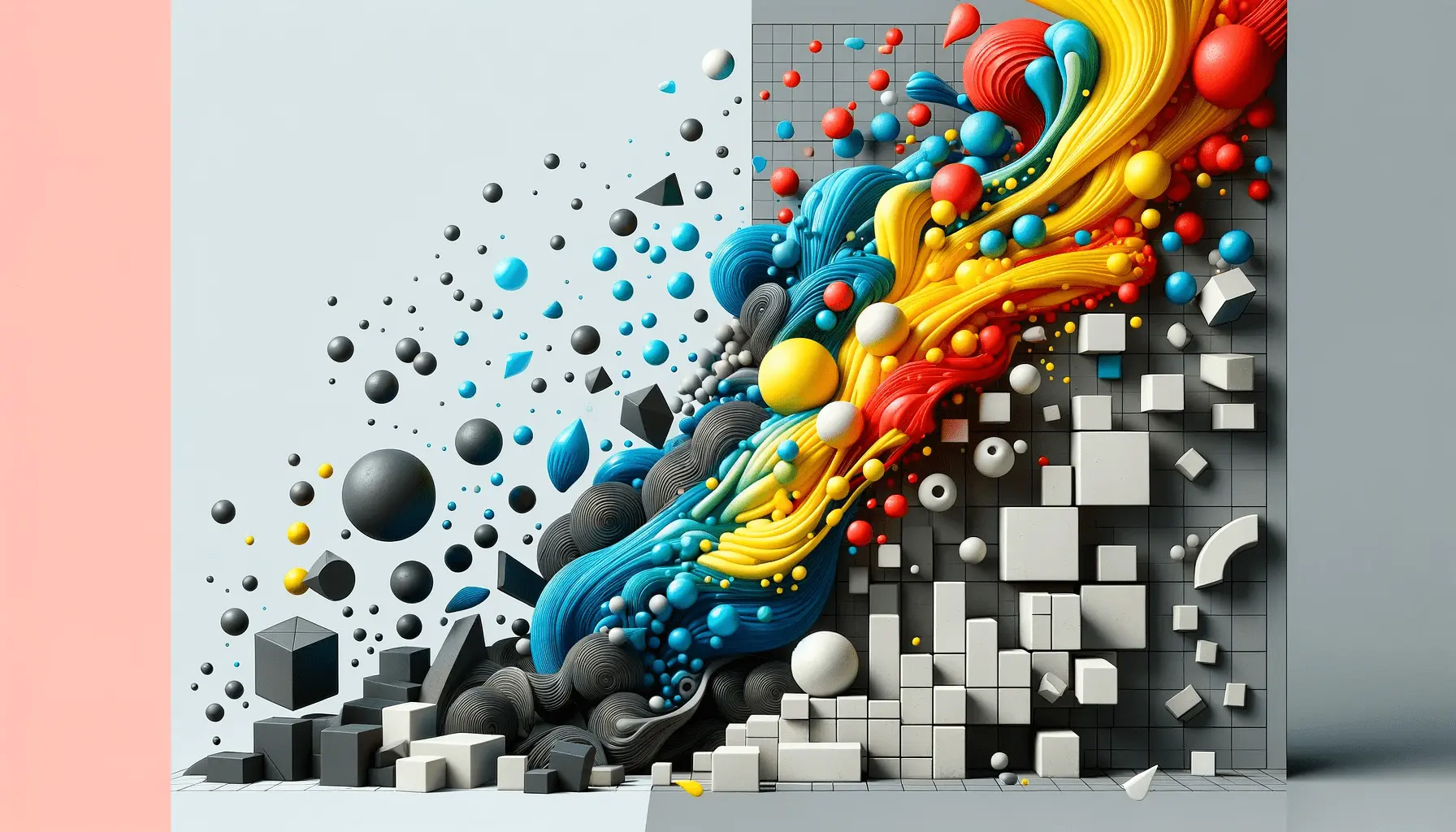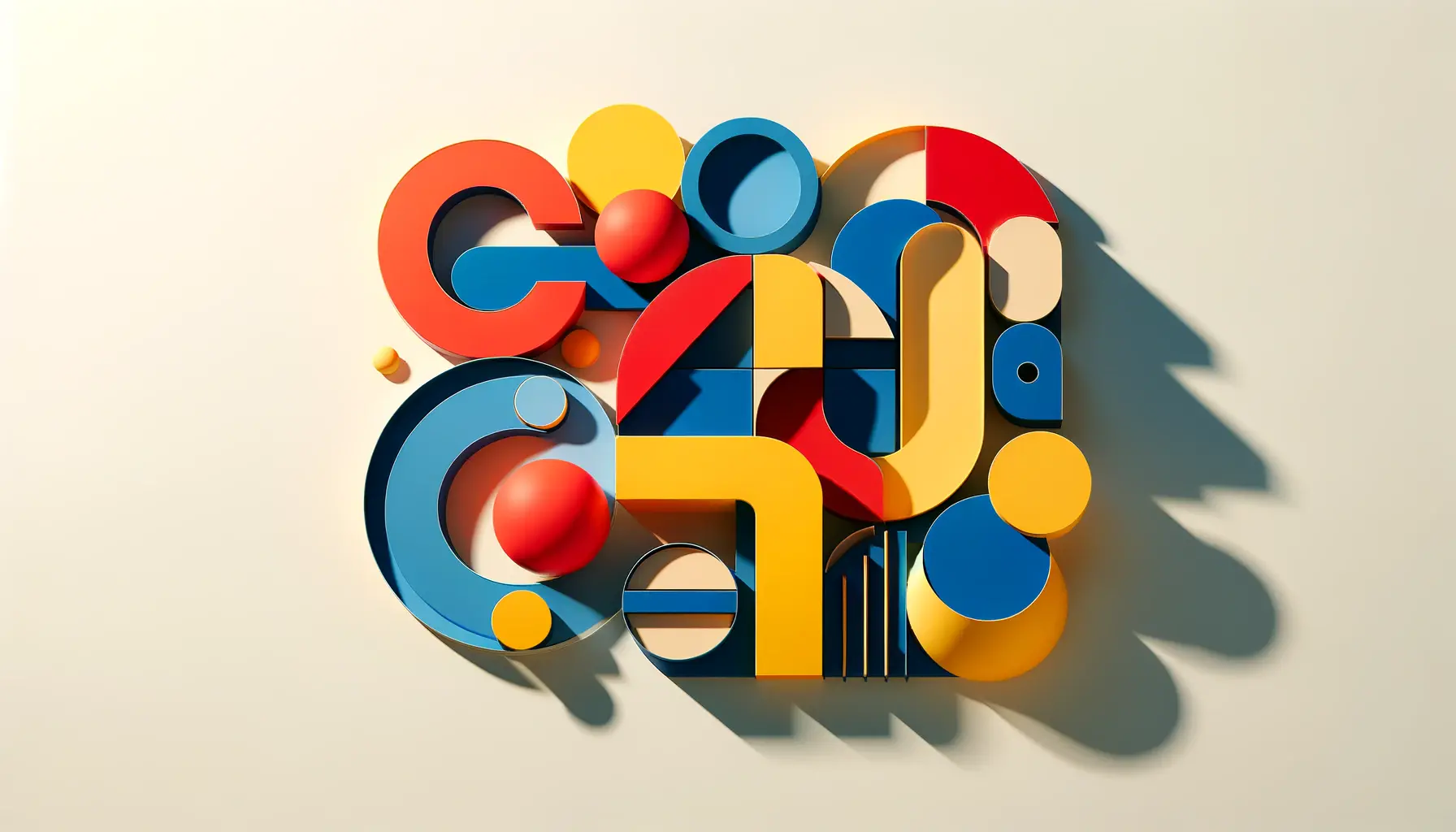In the ever-evolving environment of web design today, to be seen is no longer about bold colors or dazzling effects.
Now, designers are embracing the fluid, smooth elegance of organic shapes to transcend the rigid rule of grid and box.
Those natural shapes are revolutionizing digital beauty, bringing a human and emotional experience for consumers.
But what are organic shapes, and why do they seem to be becoming de rigueura French term meaning 'required by etiquette or current fashion; very much in style' in modern web design?
Let’s dive into the world of organic shapes and discover how they’re changing digital spaces, curve by curve.
- What Are Organic Shapes in Web Design?
- The Psychological Impact of Organic Shapes
- Methods of Using Organic Shapes
- Case Studies: Effective Application of Organic Shapes in Web Design
- Future Trends: Web Design Organic Shape Development
- The Power of Organic Shapes in Contemporary Web Design
- Most Popular Questions on Organic Shapes in Web Design
What Are Organic Shapes in Web Design?
When you hear the term organic shapes, think about flowing forms you see in nature — waves, clouds, leaves, and even freehand lines.
In contrast with mathematical geometric forms, organic shapes are irregular and freeform.
They bring movement, warmth, and softness to designs that would otherwise be sterile or mechanical.
In website design, using organic shapes brings more warmth and interactivity into the space.
These shapes usually manifest themselves as blobs, whirls, non-symmetrical patterns, or rounded lines breaking up rectangularized layouts.
Defining Organic Shapes in Digital Contexts
Organic web design shapes take their cue from nature visually.
They are non-uniform and not very symmetrical, hence giving the appearance of being alive.
They can be hand-drawn or created electronically with design applications such as Figmaa collaborative web-based design tool used for interface design and prototyping, Adobe XDa UI/UX design tool developed by Adobe for designing and prototyping user experiences, or CSS/SVGScalable Vector Graphics; an XML-based format for vector images that can scale without losing quality methods.
- They provide an organic, human-like touch to a layout.
- They add depth and contrast to what would otherwise be crisp grid-based systems.
- They foster creativity and experimentation in design.
Differences Between Geometric and Organic Forms
To appreciate the strength of organic shapes, it is helpful to contrast them with geometric shapes:
- Geometric shapes are expected — visualize squares, circles, and triangles.
- Organic shapes are unexpected — they echo the unpredictability of nature.
Where geometric design may be seen as professional and clean, it can also feel cold and lacking emotional resonance.
Organic shapes can alleviate that by conveying a sense of spontaneity and fluidity.
Why Organic Shapes Are Appropriate for Contemporary Users
Today’s users crave sincerity and emotionality in digital relationships.
The bland and rigid feel of traditional arrangements can be lifeless.
That’s where organic shapes come in — they give off feelings of creativity, freedom, and warmth.
- They help users move through content with ease.
- They break the visual habit, making designs more memorable.
- They mellow out the interface, making it more welcoming.
Proper use of organic shapes can lead users through a narrative, directing attention to important items like calls-to-action or highlighted content.
Historical Usage of Shapes in Web Design Trends
All things were boxy and grid-based in the early days of web design.
With the advancement of technology, our visual language also evolved.
Designers started playing with rounded buttons, wave separators, and hand-drawn items.
The trend towards organic shapes picked up speed as companies wanted to look more human and less machine-like.
Organic shapes are ubiquitous today — on portfolio sites and landing pages, e-commerce, and SaaS sites.
They’ve become a mass means for brands seeking differentiation and emotional connection with consumers.
So, what do you think?
Are you ready to embrace the organic charm of flowing, unobstructed design and let your imagination soar?
Organic shapes mimic natural forms like waves, clouds, and leaves—bringing life and emotional warmth to digital interfaces.
The Psychological Impact of Organic Shapes
Have you ever wondered why certain websites make you feel comfortable or keep you hooked?
The secret may lie within their design elements, most significantly the use of organic shapes.
These natural, flowing forms greatly influence user feelings and perceptions.
How Organic Forms Influence User Emotions
Organic shapes, based on nature’s curves and irregularities, provide you with a sense of comfort and friendliness.
Unlike stiff geometric shapes, these are seen as more inviting and warm, providing a superior user experience.
For instance, employing design elements like circles or curvy lines may create a sense of harmony and warmth on a web page.
Visual Softness and Illusion of Movement
Natural shapes’ softness creates an illusion of movement and fluidity in a design.
This visual softness can make interfaces less mechanical and more dynamic, engaging users more.
By mimicking the natural movement found in the environment, designers can create layouts that are more intuitive and soothing with the help of organic shapes.
Organic Shapes for Brand Identity and Trust
The application of organic shapes within a brand’s visual identity is capable of conveying trust and authenticity.
These forms imply innovation and adaptability, attributes which can appeal to users and increase the emotional affinity.
Brands wishing to seem more human-oriented and relatable will frequently use natural forms in design elements.
The Role of Shapes in UX and Cognitive Load
Applying organic shapes carefully can also have an effect on the cognitive burden on users.
Smooth, flowing layouts are less strenuous on the mind, reducing mental effort and increasing intuitive ease of use.
This can lead to a better user experience, causing users to spend more time on the website and engage more with its content.
Shapes drawn from nature can subconsciously influence how users feel, often making websites feel friendlier, more dynamic, and more memorable.
Methods of Using Organic Shapes
Using organic shapes in your web design can add life to your projects, making them more interactive and visually stimulating.
Let’s explore some effective ways to simply integrate these organic, fluid shapes into your designs.
CSS and SVG Hacks for Organic Design
CSS and SVG are a great way of creating and manipulating organic shapes:
- CSS clip-path: This property can be used to define custom shapes for elements, enabling the creation of complex, non-rectangular designs.
- SVG paths: Scalable Vector Graphics (SVG) enable the creation of intricate shapes that are always sharp on any screen size. These can be created using software like Adobe Illustrator or Inkscape and then embedded directly into your HTML.
Since these methods can be used together, you can design unique, responsive layouts that will get noticed with organic shapes.
Tips for Using Figma or Adobe XD to Design Freeform Shapes
Organic shapes can be created easily with design tools like Figma and Adobe XD:
- Pen tool: Both of these have pen tools where you can create unique, freeform shapes, providing you with freedom in your design.
- Plugins and widgets: Utilize third-party-designed plugins to produce blobs, waves, and other organic elements easily.
These tools enable rapid prototyping and feedback, so your creations will match your creative vision.
Smoothly Integrating Blobs, Waves, and Curves
To seamlessly integrate features like blobs, waves, and curves:
- Background elements: Use soft organic shapes as background elements to add depth without diverting attention from the content.
- Section dividers: Use wavy or curved section dividers to make the flow smooth and guide the eye of the viewer towards the content.
- Buttons and icons: Design call-to-action buttons or icons with rounded, organic shapes to guide users to click.
These positions can positively add to the overall appearance and usability of your site.
Balancing Aesthetics and Functionality
While organic shapes add beauty to your design, it’s also important to make it functional:
- Clarity: Keep text and interactive elements readable and easy to locate, preventing distracting complex backgrounds that make reading difficult.
- Consistency: Maintain a consistent design language by aligning the style of organic shapes with the theme and purpose of the site.
Striking this balance will mean aesthetics are adding positively to user experience, not negatively.
Responsive Design Tips for Fluid Shapes
Ensuring organic shapes resize gracefully across devices is crucial:
- Flexible layouts: Use relative units like percentages or viewport units for setting the size of shapes, so they resize reasonably with screen size.
- Media queries: Use CSS media queries to resize or move shapes on various devices, ensuring the best viewing.
- Testing: Test your designs on various devices frequently to find and fix any issues with responsiveness.
By following these habits, your designs will provide an improved and consistent experience to all users.
Tools like Figma, CSS, and SVGs allow designers to create scalable, responsive organic shapes that enhance usability and aesthetics.
Case Studies: Effective Application of Organic Shapes in Web Design
Analyzing actual applications of organic shapes in web design gives us valuable insights into their efficacy and flexibility.
Let us find some motivating instances where similar organic, flowing shapes have been successfully applied.
Brand Websites Using Organic Forms
Certain of the most advanced brands have utilized organic shapes to make their websites more efficient:
- Microsoft Surface: Microsoft Surface product pages utilize fluid shapes that blend well with product images, giving natural scroll lines and an interactive experience. The deliberate use of organic shapes enhances user interaction and navigation.
- TheraVape: TheraVape’s website design utilizes organic shapes to create a warm and welcoming look and feel that aligns with their brand emphasis on wellness and relaxation.
Impact on User Engagement and Conversion Rates
Organic shapes, when used in web design, can positively impact user engagement and conversion rates:
- Improved Visual Attractiveness: Organic shapes inject a dynamic, natural feel to websites, engaging users visually and inviting them in. This translates to more time on site and decreased bounce rates.
- Improved Navigation: Fluid shapes guide users’ gaze toward primary content and calls-to-action, creating intuitive navigation that might boost conversion rates.
Lessons Learned from Industry Leaders
Adoption of organic shapes in web design has valuable takeaways:
- Adherence to Brand Identity: Be sure the application of organic shapes aligns within the brand’s overall aesthetic and message. Adherence to style creates trust and reinforces brand recall.
- Balance of Creativity with Functionality: While organic shapes can encourage visual interest, balance usability. Avoid overuse or overly complex schemes that might hinder or confuse visitors.
- Responsive Design Considerations: Organic shapes should be implemented keeping responsiveness in view, ensuring effectiveness on various devices and screen resolutions.
By examining these case studies and observations, designers can effectively apply the potential of organic shapes toward creating engaging, user-friendly, and visually appealing web experiences.
Brands like Microsoft Surface and TheraVape have boosted engagement and emotional connection by integrating fluid shapes into their web designs.
Future Trends: Web Design Organic Shape Development
In looking to the future beyond 2025, web design use of organic shapes continues to adapt, this time indicating the way forward toward ever more organic, flowing forms.
This trend not only provides visual appeal but also operates in harmony with users’ desire for more immersive and realistic digital experiences.
Merging with Other Design Elements
Merging organic shapes with other design elements is gaining traction:
- Bolder Minimalism: Blending minimalistic form with smooth, natural shapes adds style and interest without overwhelming the user. This maintains simplicity while adding a touch of imagination.
- Textured Grains: Adding subtle textures to organic shapes can provide a tactile sensation, enriching the sensory experience of a website. This method adds warmth and legitimacy to digital interfaces.
Responsive and Adaptive Design Considerations
Making sure that organic shapes work perfectly across different devices is essential:
- Fluid Grids: Applying flexible grid systems enables organic shapes to naturally scale to different screen sizes, retaining their desired look without sacrificing usability.
- Scalable Graphics: Using SVGs (Scalable Vector Graphics) guarantees that organic shapes are displayed at their best on any device, offering a consistent visual experience.
Accessibility and User Experience
While embracing organic shapes, accessibility must be considered to ensure an inclusive user experience:
- Contrast and Readability: Make sure that text overlaid on organic backgrounds provides enough contrast for readability, supporting users with visual impairments.
- Keyboard Navigation: Make interactive elements with organic shapes keyboard-accessible to support users who use assistive technologies.
Anticipated Innovations
The future is promising for the application of organic shapes in web design:
- AI-Powered Design Tools: Artificial intelligence integration in design tools will make it easier to create complex organic shapes, enabling designers to play with new layouts easily.
- Immersive Experiences: With advancing virtual and augmented reality technologies, organic shapes will be crucial in designing immersive digital spaces that mirror the natural world.
Embracing these trends ensures that web design is dynamic, user-friendly, and in sync with the changing digital environment.
Expect organic shapes to evolve with technologies like AI and VR, leading to even more immersive and human-centered digital experiences.
The Power of Organic Shapes in Contemporary Web Design
In this article, we’ve discussed how organic shapes have revolutionized contemporary web design.
From their origins in nature-inspired designs to their current use in enhancing user experience, organic shapes give designers unlimited potential to break free from rigid constructions and create emotionally engaging digital environments.
Why Organic Shapes Are Important for Web Design
Organic shapes are quite crucial in the design of websites that are real, vibrant, and welcoming.
Their visual softness works to balance out clean, minimalist aesthetics and guide the user’s journey through fluid visual storytelling.
Whereas geometric shapes are formal and rigid, organic shapes give the impression of creativity, warmth, and friendliness—making them extremely valuable in a world where human-centered design is key.
Here’s a brief rundown of why organic shapes should be part of your design toolkit:
- They add natural movement and flow, increasing visual interest.
- They humanize digital spaces, adding emotional resonance.
- They organically draw attention to important content or CTAs.
- They reinforce brand identity when used consistently with tone and style.
- They assist accessibility and responsive design when used wisely.
Successfully Using Organic Shapes
To successfully incorporate organic shapes into your designs, make sure to balance usability with creativity.
Excessive forms or improper use can harm clarity and UX.
A purposeful plan with repetition and intention throughout design components will give the best result.
Remember this checklist when applying organic shapes in your next project:
- Start using tools like Figma, Adobe XD, or CSS/SVG to prototype and sketch.
- Utilize shapes in background elements, section dividers, and icons for subtle visual depth.
- Ensure shapes are resizable across devices through responsive frameworks.
- Test for readability and interactivity—especially on mobile—to remain accessible.
- Refine incrementally based on user feedback and analytics.
Looking Ahead: A More Natural Digital Future
The future for organic shapes in web design looks bright.
With more developments in design tools and greater AI dominance, designers will be able to create more engaging, responsive, and tailored experiences.
Whether you are building a portfolio, landing page, or ecommerce website, embracing these natural shapes can distinguish your brand in a busy online environment.
So, is your brand ready to tap into the limitless potential of organic shapes and create a more natural, intuitive, and emotive web experience?
Incorporating organic shapes isn’t just about visuals—it’s about crafting emotionally resonant, user-focused web experiences that stand out.
Quality web design is key for a great website! Check out our service page to partner with an expert web design agency.
Most Popular Questions on Organic Shapes in Web Design
Learn the most frequently asked questions to discover the role and significance of organic shapes in web design.
Organic shapes in web design refer to nature-like, non-regular, curved forms, such as leaves or waves, applied to create an organic and energetic look in web design.
Geometric shapes are symmetrical and precise, like squares and circles, while organic shapes are asymmetrical and flowing, mimicking natural patterns and forms.
Organic shapes break the monotony of geometric designs, adding movement, energy, and an organic feel to websites, making them more visually pleasing and dynamic.
Organic shapes create good feelings and intuitive experiences by guiding the user’s eye smoothly across the page, resulting in better flow and engagement.
Yes, organic shapes add uniqueness, visual interest, and a modern, dynamic feel that enhances the overall aesthetic and appeal of a website.
Organic shapes can improve functionality by establishing clear visual hierarchy and guiding users through content in a more effortless and intuitive way.
Though flexible, organic shapes must align with the website’s theme and brand identity to maintain consistency and coherence across the design.
The main challenges include maintaining responsiveness, avoiding visual clutter, and keeping the design consistent with the brand’s identity and message.
Designers can use software like Figma or Adobe XD to sketch organic shapes and apply them as backgrounds, section dividers, or icons for added depth and flow.












